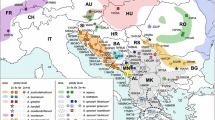Abstract
Multivariate analysis tools are exploited on a data set composed of quantitative characteristics collected on 35 populations of plants of theDactylorhiza maculata (L.)Soó group from Western-Europe. These samples lead to four well-defined clusters; this, together with qualitative, cytological and ecological arguments, allows for the recognition of four specific entities:D. maculata s.str.,D. fuchsii (Druce)Soó,D. saccifera (Brongn.)Soó andD. caramulensis (Vermeulen)Tyteca. It is concluded that the floral characters play an essential role in the taxonomical distinction. It also appears that the set of characters measured, as well as the methods exploited, are especially well-suited and valuable tools for the morphological study of the genusDactylorhiza.
Similar content being viewed by others
References
Averyanov, L., 1989: Conspectus generisDactylorhiza Neck. exNevski (Orchidaceae), 2 (Russian). — Nov. Syst. Plant. Vasc.26: 47–56.
Bateman, R. M., Denholm, I., 1983: A reappraisal of the British and Irish dactylorchids, 1. The tetraploid marsh-orchids. — Watsonia14: 347–376.
, 1985: A reappraisal of the British and Irish dactylorchids, 2. The diploid marshorchids. — Watsonia15: 321–355.
, 1988: A reappraisal of the British and Irish dactylorchids, 3. The spotted-orchids. — Watsonia17: 319–349.
, 1989: On measuring marsh-orchids. Morphometric procedure, taxonomic objectivity and marsh-orchid systematics. — Watsonia17: 449–455.
Baumann, H., Künkele, S., 1988: Die Orchideen Europas. — Stuttgart: Kosmos Naturführer, Franckh'sche Verlagshandlung, W. Keller & Co.
Buttler, K. P., 1986: Orchideen. — Die wildwachsenden Arten und Unterarten Europas, Vorderasiens und Nordafrikas. — München: Steinbachs Naturführer, Mosaik Verlag.
Camus, E. G., Camus, A., 1921–1929: Iconographie des orchidées d'Europe et du bassin méditerranéen. — Paris: Lechevalier.
Darwin, C., 1862: On the various contrivances by which British and foreign orchids are fertilised by insects, and on the good effects of inter-crossing. — London.
Dressler, R. L., 1981: The orchids. — natural history and classification. — Cambridge, London: Harvard University Press.
Gathoye, J.-L., Tyteca, D., 1987: Étude biostatistique desDactylorhiza (Orchidaceae) de Belgique et des territoires voisins. — Bull. Jard. Bot. Nat. Belgique57: 389–424.
, 1989: Contribution à l'étude cytotaxonomique desDactylorhiza d'Europe occidentale. — Mém. Soc. Roy. Bot. Belgique11:30–42.
Gölz, P., Reinhard, H. R., 1973: Biostatistische Untersuchungen an europäischen Orchideen. — Ber. Schweiz. Bot. Ges.83: 93–105.
, 1975: Biostatistische Untersuchungen überOphrys bertoloniiformis O. & E. Danesch. — Ber. Schweiz. Bot. Ges.85: 31–56.
, 1984: Die Orchideenflora Albaniens—OPTIMA-Projekt „Kartierung der mediterranen Orchideen“. — Mitt. Bl. Arbeitskr. heim. Orch. Baden-Württ.16: 193–394.
, 1986: Orchideen in Jugoslawien. — Mitt. Bl. Arbeitskr. heim. Orch. Baden-Württ.18: 689–827.
Heslop-Harrison, J., 1951: A comparison of some Swedish and British forms ofOrchis maculata L. sens. lat. — Svensk Bot. Tidskr.45: 608–635+4 pl
, 1968: Genetic system and ecological habit as factors in Dactylorchid variation. — Jahresber. naturwiss. Vereins Wuppertal21/22: 20–27.
Jagiełło, M., 1988: Analysis of population variability and distribution of species from theDactylorhiza maculata group (Orchidaceae) in Poland. — Fragm.Flor. Geobot.31–32: 333–383.
Kalteisen, M., Reinhard, H. R., 1986: Orchideen im zentralen italienischen Südalpenraum. — Mitt. Bl. Arbeitskr. heim. Orch. Baden-Württ.18: 1–136.
Legendre, P., Fortin, M.-J., 1989: Spatial pattern and ecological analysis. — Vegetatio80: 107–138.
McQueen, J. B., 1967: Some methods for classification and analysis of multivariate observations. — InLe Cam, L. M., Neyman, J. (Eds.): Proc. fifth Berkeley Symp. Math. Stat. Probab. 1, pp. 281–297. — Berkeley: University of California Press.
Moore, D. M., (Ed.), 1980:Orchidaceae. — InTutin, T. C., & al., (Eds.): Flora Europaea5, pp. 325–350. — Cambridge: Cambridge University Press.
Nelson, E., 1976: Monographie und Ikonographie der Orchidaceen-GattungDactylorhiza. — Zürich: Speich AG.
Reinhard, H. R., 1985: Skandinavische und alpineDactylorhiza-Arten (Orchidaceae). — Mitt. Bl. Arbeitskr. heim. Orch. Baden-Württ.17: 321–416.
, 1990: Kritische Anmerkungen zu einigenDactylorhiza-Arten (Orchidaceae) Europas. — Mitt. Bl. Arbeitskr. heim. Orch. Baden-Württ.22: 1–72.
SAS Institute, Inc., 1982: SAS user's guide: statistics. — Cary, N.C.: SAS Institute, Inc.
Sneath, P. H. A., Sokal, R. R., 1973: Numerical taxonomy. The principles and practice of numerical classification. — San Francisco: Freeman.
Somers, K. M., 1986: Multivariate allometry and removal of size with principal components analysis. — Syst. Zool.35: 359–368.
, 1989: Allometry, isometry and shape in principal components analysis. — Syst. Zool.38: 169–173.
Späth, H., 1980: Cluster analysis algorithms. — Chichester: Ellis Horwood.
Sundermann, H., 1980: Europäische und mediterrane Orchideen. — Eine Bestimmungsflora. 3rd edn. — Hildesheim: Brücke-Verlag Kurt Schmersow.
Tyteca, D., 1989: Orchidées du Portugal—Remarques sur les espèces du genreDactylorhiza. — L'Orchidophile20: 153–160.
, 1988: LesDactylorhiza d'Europe occidentale: approche biostatistique. — Natural. Belges69, no. spécial “Orchidées”: 65–97.
, 1989: Contribution à l'étude biostatistique desDactylorhiza d'Europe occidentale. — Mém. Soc. Roy. Bot. Belgique11: 43–64.
Vanhecke, L., 1989: Intraclonal variation and intercorrelation of morphological characters inDactylorhiza praetermissa: evidence for allometry inOrchidaceae. — Mém. Soc. Roy. Bot. Belgique11: 65–86.
van Straaten, D., Peymen, J., Schneiders, A., Verheyen, R., 1988: The morphological variation of a population ofDactylorhiza maculata (L.)Soó (s.l.) in a base-rich marsh (Het Buitengoor, Belgium). — Bull. Jard. Bot. Nat. Belgique58: 477–501.
Vermeulen, P., 1970: Some critical remarks on the dactylorchids of Portugal. — Bol. Soc. Brot., Sér. 2,44: 85–98.
Vöth, W., Greilhuber, J., 1980: Zur Karyosystematik vonDactylorhiza maculata s.l. und ihrer Verbreitung, insbesondere in Niederösterreich. — Linzer Biol. Beitr.12(2): 415–468.
Author information
Authors and Affiliations
Rights and permissions
About this article
Cite this article
Dufrêne, M., Gathoye, JL. & Tyteca, D. Biostatistical studies on western EuropeanDactylorhiza (Orchidaceae)—theD. maculata group. Pl Syst Evol 175, 55–72 (1991). https://doi.org/10.1007/BF00942145
Received:
Revised:
Accepted:
Issue Date:
DOI: https://doi.org/10.1007/BF00942145




